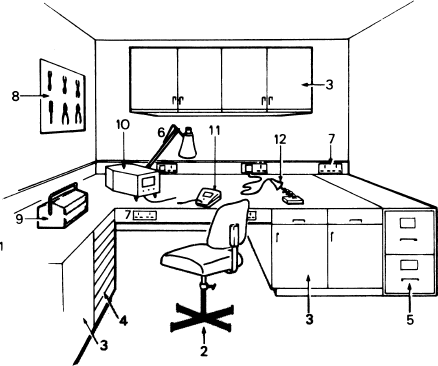Equipment Maintenance Area
Although maintenance is of several distinct types (mechanical, electrical, electronic, plant etc.), a single general purpose servicing area close to the studio is the minimum requirement. It should have doors wide enough to permit access of bulky studio equipment and windows, if any, fitted with blinds. Laminated plastic working surfaces should be at a convenient height for staff to work either standing or seated on a stool. A generous number of power outlets should be provided at the rear of the bench. Sound and vision tie-lines from the studio carrying pulses and test signals, with some spare lines, are essential. Local extract ventilation (LEV) must be provided with particular attention to solder fumes which can be harmful.
Storage
Maintenance engineers are renowned hoarders of things which ‘could come in useful’; thus, compromise has to be made between legroom and storage. Some drawers with labelled compartments for the storage of small electrical components are desirable so that they may be located quickly. Cables are usually stored on wall hooks.
A tool roll or box for small tools including screwdrivers, pliers etc. is also necessary. Larger tools may be kept in a drawer, though a preferred system is to hang them on a wall to enable a visual check to be kept. Each tool is allocated a hook over a painted silhouette of the tool. The bench should have a precision soldering station, a good quality vice and an illuminated desk magnifier. A filing cabinet for manuals, technical literature and fault records should be provided together with a plan chest for system diagrams etc.
Test equipment
Some items of electronic equipment are essential: a precision oscilloscope (with high gain and dual beam capability), a vectorscope, two multi-meters for simultaneous measurements and a variable power supply. For precision camera alignment a grey scale and a light meter are essential. For complex, miniaturised or digital equipment it may be cost-effective to ensure that manufacturers or suppliers can offer a maintenance back-up service rather than invest in sophisticated maintenance equipment and highly skilled staff. Modern equipment is very reliable yet complex, making fault finding difficult and time-consuming for an engineer who may not have an intimate knowledge of its design.
Lighting
In addition to conventional lighting there should be fluorescent lighting directly over the working surfaces together with adjustable table lamps. An inspection lamp or torch can also prove very useful.

Typical studio maintenance room
This general purpose maintenance room provides regular servicing facilities (electrical, electronic, mechanical) for the small studio.
Furnishings include: (1) plastic-topped heavy-duty bench, (2) vari-height stool with back support, (3) storage cupboards/drawers, (4) small component drawers, (5) document filing cabinet, (6) adjustable wall lamp, (7) extensive power points. Tools include: (8) large items on storage rack, (9) comprehensive portable tool kit, (10) oscilloscope, (11) multimeter, (12) soldering iron with heat-shield stand (a desoldering station is also required).
For safety, only qualified staff should use the area. An isolator near the door for making the area electrically safe is essential, and local extract ventilation for solder fumes should be provided.
